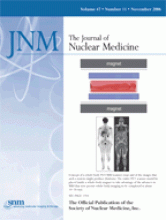PET past and future: Cherry takes a retrospective look at key advances in PET technology, highlights 3 emerging themes that point to near-term developments, and speculates on the design and performance of PET scanners in the future. …Page 1735
RAIT in solid tumors: Goldenberg reviews the rationale and preliminary evidence for applying radioimmunotherapy to solid tumors and previews an article in this issue of JNM on its use after surgery in intraabdominal cancers. …Page 1746
Complementary coronary assessments: Schuijf and colleagues compare the results of multislice CT and gated SPECT imaging on a regional basis in patients with known or suspected coronary artery disease. …Page 1749
Myocardial ischemia and RT: Gayed and colleagues investigate the prevalence of myocardial perfusion abnormalities in patients who have undergone 3D conformal or intensity-modulated radiation as part of treatment regimens for esophageal cancer. …Page 1756

PET in ischemic heart disease: Thompson and colleagues use 18F-FDG and 82Rb PET to explore the effect of left bundle branch block on septal metabolism in patients with ischemic cardiomyopathy and left ventricular dysfunction. …Page 1763
Cardiac denervation in movement disorders: Raffel and colleagues apply 11C-HED and 11C-DTBZ PET in the investigation of cardiac denervation in patients with idiopathic Parkinson's disease, multiple system atrophy, and progressive supranuclear palsy. …Page 1769

Identifying Alzheimer's biomarkers: Mosconi and colleagues compare brain atrophy and hypometabolism as preclinical markers of disease by studying presymptomatic individuals from families with early-onset Alzheimer's disease. …Page 1778
Brain protein synthesis: Sundaram and colleagues assess the effect of plasma concentrations of leucine and large neutral amino acids on PET brain tracer uptake rates in the search for stable indices of altered protein synthesis in neurologic disorders. …Page 1787
Atypical 11C-DASB metabolism: Parsey and colleagues examine the effects of saturating lung serotonin transporters with sertraline to prevent initial trapping of 11C-DASB in PET imaging. …Page 1796
Furosemide challenge in abdominopelvic PET: Kamel and colleagues evaluate the utility of forced diuresis for resolving confounding lesions and improving the accuracy of 18F-FDG PET imaging in the lower urinary tract and adjacent areas. …Page 1803

PET definition of GTV: Biehl and colleagues explore the feasibility of defining an optimal maximum standardized uptake value threshold for gross volume delineation by PET in treatment planning for peripheral primary non–small cell lung cancer tumors. …Page 1808
Cell death predicts therapy response: Rottey and colleagues evaluate changes in relative 99mTc-HYNIC-annexin V tumor uptake in patients undergoing chemotherapy for a variety of cancers to determine whether responders can be identified within days of therapy initiation. …Page 1813

Radionuclide imaging of the urinary tract: Boubaker and colleagues provide an educational overview of the role of nuclear medicine procedures in investigating renal and parenchymal disease and upper urinary tract abnormalities. …Page 1819
Noninvasive myocardial infarct imaging: Stegger and colleagues research the accuracy and efficiency of 18F-FDG PET for quantification of infarct size in mice, compare the results with histomorphometry, and discuss the implications of this technique for longitudinal studies. …Page 1837

Monitoring atherosclerosis therapy: Ogawa and colleagues investigate the usefulness of 18F-FDG PET for monitoring plaque-stabilizing pharmacologic therapies that target vascular inflammation. …Page 1845

Myocardial gene imaging safety: Lee and colleagues conduct research in a rat model to determine whether myocardial sodium iodide symporter gene imaging causes myocardial injury or perturbs cardiac function. …Page 1851
Functional rat brain templates: Casteels and colleagues report on the construction of atlases for voxel-based functional mapping of the rat brain and discuss the future potential for small-animal PET molecular imaging with advanced image processing. …Page 1858

mAbs and RIT: Koppe and colleagues assess the efficacy of adjuvant radioimmunotherapy using radiolabeled monoclonal antibodies after cytoreductive surgery in rats with peritoneal carcinomatosis of colonic origin. …Page 1867
Predicting dose-limiting toxicity: Brindle and colleagues conduct cadaver-based studies in an attempt to construct a predictive model of the total skeletal spongiosa volume that would be a clinically useful tool for improving patient specificity in skeletal dosimetry. …Page 1875

“Hybrid” collimation: Metzler and colleagues reevaluate the sensitivity and resolution capabilities of “slit-slat” collimation and compare these with those of single-pinhole and parallel-beam collimators. …Page 1884
Evaluating new technologies: Wang and colleagues report on the performance characteristics of the eXplore VISTA dual-ring small-animal PET scanner, including its depth-of-interaction or parallax correction capability. …Page 1891

ON THE COVER
Integration of a whole-body PET system with MRI would make possible whole-body kinetic studies showing the underlying anatomy, with applications in areas such as pharmacokinetics, dosimetry, and cell- trafficking studies. The obvious objection to such a system is its likely expense. To realize such a system in anything other than an elite medical research environment would require significant reductions in cost. But putting cost aside, it is likely that the PET component of such a system could be built even with current technology, and with recent developments the combination of PET and MRI is looking increasingly feasible.

SEE PAGE 1743







